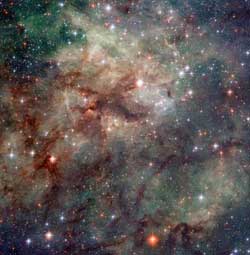Arachnophobes beware: Hubble snaps close-up of the Tarantula

Hubble has taken this stunning close-up shot of part of the Tarantula Nebula. This star-forming region of ionised hydrogen gas is in the Large Magellanic Cloud, a small galaxy which neighbors the Milky Way. It is home to many extreme conditions including supernova remnants and the heaviest star ever found. The Tarantula Nebula is the most luminous nebula of its type in the local universe. Credit: NASA, ESA<br>
The part of the nebula visible in this image from Hubble's Advanced Camera for Surveys is criss-crossed with tendrils of dust and gas churned up by recent supernovae. These supernova remnants include NGC 2060, visible above and to the left of the centre of this image, which contains the brightest known pulsar.
The tarantula's bite goes beyond NGC 2060. Near the edge of the nebula, outside the frame, below and to the right, lie the remains of supernova SN 1987a, the closest supernova to Earth to be observed since the invention of telescopes in the 17th century.
Hubble and other telescopes have been returning to spy on this stellar explosion regularly since it blew up in 1987, and each subsequent visit shows an expanding shockwave lighting up the gas around the star, creating a pearl necklace of glowing pockets of gas around the remains of the star. SN 1987a is visible in wide field images of the nebula, such as that taken by the MPG/ESO 2.2-metre telescope.
Together with dying stars, the Tarantula Nebula is packed with young stars which have recently formed from the nebula's supply of hydrogen gas. These toddler-stars shine forth with intense ultraviolet light that ionises the gas, making it light up red.
The light is so intense that although around 170 000 light-years distant, and outside the Milky Way, the Tarantula Nebula is nevertheless visible without a telescope on a dark night to Earth-bound observers. This nebula might be far away, but it is the most luminous example of its type that astronomers have observed in the local Universe.
A compact and extremely bright star cluster called RMC 136 (http://www.spacetelescope.org/images/opo0932a/) lies above and to the left of this field of view, providing much of the radiation that powers the multi-coloured glow. Until recently, astronomers debated whether the source of the intense light was a tightly bound cluster of stars, or perhaps an unknown type of super-star thousands of times bigger than the Sun. It is only in the last 20 years, with the fine detail revealed by Hubble and the latest generation of ground-based telescopes, that astronomers have been able to conclusively prove that it is, indeed, a star cluster.
But even if the Tarantula Nebula doesn't contain this hypothetical super-star, it still hosts some extreme phenomena, making it a popular target for telescopes. Within the bright star cluster lies star RMC 136a1, which was recently found to be the heaviest ever discovered, at around 300 times the mass of the Sun at its birth (http://www.eso.org/public/news/eso1030/). This heavyweight is challenging astronomers' theories of star formation, smashing through the upper limit they thought existed on star mass.
Notes
The Hubble Space Telescope is a project of international cooperation between ESA and NASA.
Image credit: NASA, ESA
Links
– Images of Hubble: http://www.spacetelescope.org/images/archive/category/spacecraft/
– http://en.wikipedia.org/wiki/Tarantula_Nebula
– http://www.naic.edu/~gibson/30dor/
– http://coolcosmos.ipac.caltech.edu/cosmic_classroom/multiwavelength_
astronomy/multiwavelength_museum/30dor.html
– http://apod.nasa.gov/apod/ap081111.html
– http://www.eso.org/public/news/eso1030/
– http://en.wikipedia.org/wiki/R136a1
– http://en.wikipedia.org/wiki/R136
– http://seds.org/messier/xtra/ngc/lmc_sn1987A.html
– http://www.eso.org/public/news/eso1033/
Contacts
Oli Usher
Hubble/ESA
Garching bei München, Germany
Tel: +49-89-3200-6855
Email: ousher@eso.org
Media Contact
More Information:
http://www.eso.orgAll latest news from the category: Physics and Astronomy
This area deals with the fundamental laws and building blocks of nature and how they interact, the properties and the behavior of matter, and research into space and time and their structures.
innovations-report provides in-depth reports and articles on subjects such as astrophysics, laser technologies, nuclear, quantum, particle and solid-state physics, nanotechnologies, planetary research and findings (Mars, Venus) and developments related to the Hubble Telescope.
Newest articles

Properties of new materials for microchips
… can now be measured well. Reseachers of Delft University of Technology demonstrated measuring performance properties of ultrathin silicon membranes. Making ever smaller and more powerful chips requires new ultrathin…

Floating solar’s potential
… to support sustainable development by addressing climate, water, and energy goals holistically. A new study published this week in Nature Energy raises the potential for floating solar photovoltaics (FPV)…

Skyrmions move at record speeds
… a step towards the computing of the future. An international research team led by scientists from the CNRS1 has discovered that the magnetic nanobubbles2 known as skyrmions can be…





















